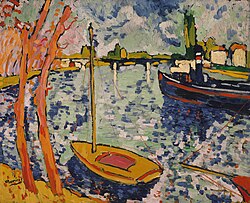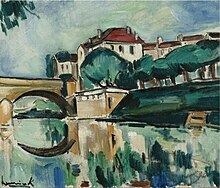How Is the Title of an Art Exhibit Punctuated?
| Maurice de Vlaminck | |
|---|---|
 Maurice de Vlaminck. The River Seine at Chatou, 1906, Metropolitan Museum of Fine art | |
| Born | (1876-04-04)iv April 1876 Paris, France |
| Died | xi October 1958(1958-10-11) (aged 82) Rueil-la-Gadelière, France |
| Known for | Painting |
Maurice de Vlaminck (four April 1876 – 11 October 1958) was a French painter. Along with André Derain and Henri Matisse he is considered ane of the main figures in the Fauve movement, a grouping of modern artists who from 1904 to 1908 were united in their use of intense color.[1] Vlaminck was one of the Fauves at the controversial Salon d'Automne exhibition of 1905.
Life [edit]

Photo of André Derain (left) and Vlaminck (right), 1942
Maurice de Vlaminck was born on Rue Pierre Lescot in Paris. His begetter Edmond Julien was Flemish and taught violin and his mother Joséphine Caroline Grillet came from Lorraine and taught piano.[2] His male parent taught him to play the violin.[3] He began painting in his late teens. In 1893, he studied with a painter named Henri Rigalon on the Île de Chatou.[4] In 1894 he married Suzanne Berly. The turning point in his life was a chance coming together on the railroad train to Paris towards the end of his stint in the army. Vlaminck, then 23 and already active in anarchist circles in Paris,[v] met an aspiring artist, André Derain, with whom he struck upwardly a lifelong friendship.[3] When Vlaminck completed his army service in 1900, the two rented a studio together, the Maison Levanneur, which at present houses the Cneai,[6] for a year earlier Derain left to exercise his own military service.[3] In 1902 and 1903 he wrote several mildly pornographic novels illustrated by Derain.[7] He painted during the day and earned his livelihood by giving violin lessons and performing with musical bands at dark.[three]

Barges on the Seine (Bateaux sur la Seine), 1905-06, oil on canvas, 81 x 100 cm, Pushkin Museum, Moscow

Le bassin à Chatou (White Sailboat at Chatou), 1907, oil on canvas, 60.2 x 73.7 cm, individual collection
Vlaminck participated in the controversial 1905 Salon d'Automne exhibition. Later viewing the boldly colored canvases of Vlaminck, Henri Matisse, André Derain, Albert Marquet, Kees van Dongen, Charles Camoin, and Jean Puy, the art critic Louis Vauxcelles disparaged the painters as "fauves" (wild beasts), thus giving their motility the name by which information technology became known, Fauvism.[8]
In 1911, Vlaminck traveled to London and painted by the Thames. In 1913, he painted again with Derain in Marseille and Martigues. In World War I he was stationed in Paris, and began writing verse. Somewhen he settled in Rueil-la-Gadelière, a small village south-west of Paris. He married his second wife, Berthe Combes, with whom he had two daughters. From 1925 he traveled throughout France, but continued to paint primarily along the Seine, near Paris. Resentful that Fauvism had been overtaken by Cubism as an art motility Vlaminck blamed Picasso "for dragging French painting into a wretched dead finish and land of defoliation". During the Second Globe War Vlaminck visited Germany and on his return published a tirade against Picasso and Cubism in the periodical Comoedia in June 1942. Vlaminck wrote many autobiographies.[9]
Vlaminck died in Rueil-la-Gadelière on xi October 1958.
Creative career [edit]

Town on the Bank of a Lake, c.1909, oil on canvas, 81.3 x 100.3 cm, Hermitage Museum, Leningrad

Le pont de Poissy, c.1910, oil on canvas, 46.4 x 54.9 cm

Two of Vlaminck's groundbreaking paintings, Sur le zinc (At the Bar) and 50'homme a la pipage (Man Smoking a Pipe) were painted in 1900.[3]
For the adjacent few years Vlaminck lived in or nigh Chatou (the inspiration for his painting houses at Chatou), painting and exhibiting alongside Derain, Matisse, and other Fauvist painters. At this time his exuberant paint application and vibrant use of colour displayed the influence of Vincent van Gogh. Sur le zinc called to mind the work of Toulouse-Lautrec and his portrayals of prostitutes and solitary drinkers, only does not attempt to probe the sitter's psychology—a interruption with the century-old European tradition of individualized portraiture.[3] According to art critic Souren Melikian, information technology is "the impersonal cartoon of a blazon."[3] In his landscape paintings, his approach was similar. He ignored the details, with the landscape becoming a vehicle through which he could express mood through violent colour and brushwork.[3] An example is Sous bois, painted in 1904. The following year, he began to experiment with "deconstruction," turning the physical world into dabs and streaks of colour that convey a sense of motility.[3] His paintings Le Pont de Chatou (The Chatou Bridge), Les Ramasseurs de pommes de terre (The Murphy Pickers), La Seine a Chatou (The River Seine at Chatou) and Le Verger (The Orchard) exemplify this trend.[3]
Artistic influences [edit]
Vlaminck's compositions show familiarity with the Impressionists, several of whom had painted in the same area in the 1870s and 1880s. Afterward visiting a Van Gogh exhibit, he declared that he "loved Van Gogh that day more than than my own father".[10] From 1908 his palette grew more monochromatic, and the predominant influence was that of Cézanne.[vii] His later on work displayed a night palette, punctuated by heavy strokes of contrasting white pigment.
Some of his works are held at the Minneapolis Found of Art.[eleven]
Notes and references [edit]
- ^ Freeman, Judi, et al. The Fauve Landscape, pp.13–xiv. Abbeville Press, 1990. ISBN 1-55859-025-0
- ^ Clement, Russell T. (1994). Les Fauves: A Sourcebook . Greenwood Publishing Group. p. 341. ISBN0-313-28333-viii.
- ^ a b c d e f 1000 h i j Melikian, Souren. "Vlaminck: Expressing mood with color", International Herald Tribune, eleven July 2008. Retrieved thirteen July 2008.
- ^ Freeman, page 319.
- ^ Patricia Leighten, 'A Politics of Technique' in Anarchism and the Avant-garde (Brill: Amsterdam, 2019), p73f
- ^ Cneai
- ^ a b Freeman, p.319.
- ^ Louis Vauxcelles, Le Salon d'Automne, Gil Blas, 17 October 1905. Screen 5 and 6. Gallica, Bibliothèque nationale de French republic, ISSN 1149-9397
- ^ Freeman, pages 123, 319
- ^ Freeman, pp.15-21
- ^ "Maurice de Vlaminck ^ Minneapolis Institute of Art". collections.artsmia.org . Retrieved 17 February 2018.
External links [edit]
- Maurice de Vlaminck on artnet
- 75 images of de Vlaminck's painting art, on Wikiart
- Maurice de Vlaminck Bio - Findlay Galleries
- Maurice de Vlaminck - Biography
- Works by Maurice de Vlaminck (public domain in Canada)
wilsonusionswut53.blogspot.com
Source: https://en.wikipedia.org/wiki/Maurice_de_Vlaminck
0 Response to "How Is the Title of an Art Exhibit Punctuated?"
Post a Comment